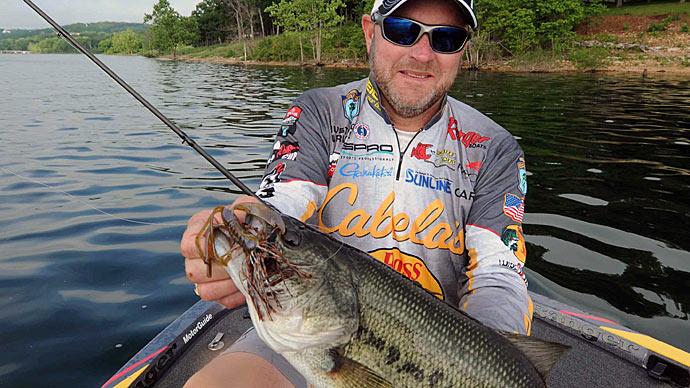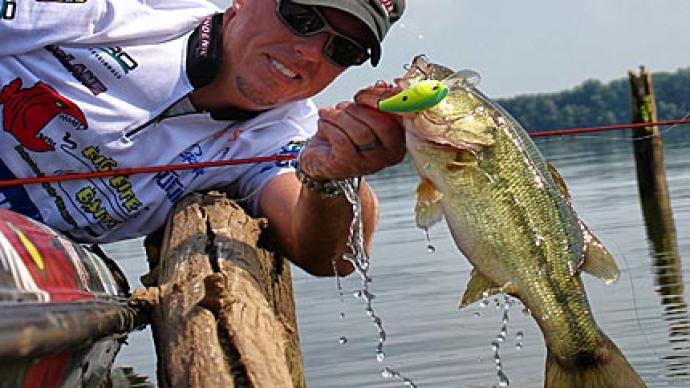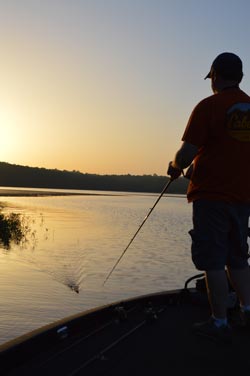
Post spawn has always been considered a tough time of year to fish for bass. The common perception has been that fish are in a funk, sulking and refusing to eat much of anything as they recuperate from the rigors of spawning. Persistent anglers can catch a few, but they need to cover lots of water and set their expectations for only a few bites spread throughout the day.
But times have changed. Savvy anglers know that post-spawn bass are spread out, not sulking, and ready to eat. It’s all about keeping up with them during this busy season. And that makes it perfect for fishing topwaters.
Topwaters can be fished quickly, so it’s easy to cover water quickly. And they fish well around the cover bass are using and mimicking the forage they are eating, not only during post-spawn post-spawn straight through early summer.
How long this topwater window remains open depends on water conditions. Falling levels and rising temperatures often mark the end of these shallow bites. But before that happens, here are five prime topwater patterns to try.
Fry guarders
Not all bass leave the shallows after they’re done spawning. While nearly all the bigger females start migrating to their early summer haunts, male bass remain behind for up to three weeks, guarding eggs and then newly hatched fry by running off predators such as bluegill. They make up for their smaller, on average size with numbers and aggressiveness. And that’s a combination made for fast topwater action.
Male bass herd fry through shallow water, holding in any cover they pass, especially brush and aquatic vegetation. Flooded bushes, tops of laydown trees, patches of lily pads, and emergent aquatic vegetation are some of their favorites. They are dense but have enough space inside for fry to swim, and their sharp edges are easy for male bass to patrol.
Male bass take their parenting seriously, doling out quick attacks to any predator — or lure — that comes too close to their fry. It won’t take long for you to find out if one is around, and there’s no point in finessing strikes from them. These bass aren’t choosey, so practically any topwater lure will draw strikes.
If the water is stained or has a little chop, choose a noisy lure such as a small prop bait or popper. Try a small walking bait in clear water, such as a Zara Spook Puppy or Megabass Dog-X. All should be fished close to the available cover.
Water that’s slick and extremely clear offers the perfect opportunity to fish a balsa minnow such as a Bagley Bang O Lure or Rapala Original Minnow. Use 10-pound test or less monofilament line — no fluorocarbon line because it sinks — and a loop knot to attach the lure. Make a long cast, moving the minnow along the surface with quick twitches and pauses that last as long as it takes for the ripples to disappear. An alternate retrieve involves holding the rod tip high and reeling fast enough to make the minnow wobble under the surface.
Shad spawn
The biggest post-spawn pattern to hit bass fishing over the last decade has to be targeting the shad spawn. These baitfish, mostly the threadfin variety found across the United States, spawn when the water temperature is between the mid-60s and mid-70s, which is soon after bass finish spawning.
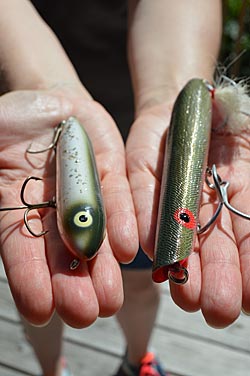
There only is a small window of time to take advantage of the shad-spawn bite each day. You must be on the water early or late when light levels are lowest. And they don’t spawn everywhere. Riprap or other rock, seawalls, docks, thick aquatic vegetation, and willow trees that are flooded or whose branches dip into the water can provide enough cover for them to spawn. You’ll see them flittering in the cover and dimpling the water’s surface.
Most anglers chase shad-spawn bass with shallow-diving crankbaits and spinnerbaits. Some use soft jerkbaits. But it also is an excellent time to throw topwaters.
Walking baits are a good choice, but a better one is a buzzbait. Its blade mimics the flash and surface disruption made by spawning shad, and the skirt provides a perfect target for feeding bass. For a thicker cover, try a soft-plastic toad. Its commotion and profile are similar to a buzzbait. And these bass aren’t going to stop to wonder why a toad is swimming above. They’re too keyed on size, action, and color — so choose ones in baitfish hues.
You’ll want a smaller buzzbait, so use one that weighs 3/8 ounce or less. Single or double blades will work, and like with the toads, pick one in a baitfish color. There’s no need to go wimpy on your line because most of it will be out of the water during your retrieves. So, use 15-pound test or stronger monofilament.
Herring spawn
Blueback herring are a unique baitfish that swims in some Southern reservoirs. It spends most of the year suspended in open water. But just as bass finish their spawn, they come shallow to spawn. It’s a situation that can produce fantastic topwater fishing, especially on Hartwell and Clarks Hill, Savannah River reservoirs along the Georgia-South Carolina line, and Lake Murray near Columbia, S.C.
The herring spawn on shallow flat points that are mostly clay, sometimes with scattered wood or rock. Wind and waves stir them up — some anglers use their boat’s wake on calm days — offering the perfect opportunity for bass to feast. And they won’t be small bass. Most herring are between 7 and 10 inches long.
Walking topwater lures, such as a full-sized Heddon Zara Spook, are popular choices for the herring spawn. And a favorite among anglers fishing the Savannah River lakes is a saltwater lure, the Cotton Cordell Pencil Popper. With a weighted tail and small concave head, it’s easy to work across the surface.
Long casts are essential, so lean toward a 7-foot or longer rod and a reel that you feel comfortable casting. Braid — 30- to 50-pound test — will cast farther than monofilament and give surer hook sets at longer distances, thanks to zero stretches.
Bluegill beds
Bluegills head to the shallows to spawn not long after the bass finish, and they keep spawning through the summer on each full moon. It’s an annual event that rarely goes unnoticed by some of the biggest bass in a lake, reservoir, or river.
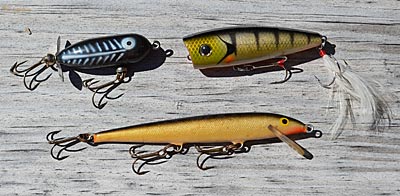
Look for bluegill beds along quiet stretches of shallow water. The bottom needs to be soft, such as sand or clay, and docks or aquatic vegetation will make a spot better but aren’t necessary. The beds, which look like small craters, are grouped, and you’ll see bluegill swimming around them when the water is clear. You’ll see bass, too.
This is an excellent opportunity to fish a prop bait such as a Brian's Crankbaits Prop Bee. Its shape resembles bluegill, and the props on each end cause enough disturbance to attract bass. Frogs are another topwater lure that works well in this situation, especially if there is plenty of aquatic vegetation. Keep your color choices simple; the brighter the lure, the better.
Regardless of which topwater lure you tie on, patience is vital. A short twitch or two will be enough to get the attention of a bass lurking around bluegill beds. And a pause that lasts well beyond when the last ripples disappear will force it to strike. It's fishing slow but fast: The movements made during your retrieve are slow, but because you can see a bass coming, you can move on if your lure doesn’t draw interest from one.
Expect to catch one or two bass from each group of bluegill beds. But the ones you do catch will be bigger than average. So, use stout monofilament and a medium-action heavy power rod, making it easier to work your lure and land large bass.
Shallow grass
Largemouth love aquatic vegetation, both emergent and submergent, and an excellent place to look for them during post-spawn and early summer are shallow flats covered with it that lie between spawning spots and deeper water. Schools of bass will congregate there until higher water temperatures or falling water levels push them, or their food, to their summer haunts.
Frogs are a great topwater lure to use in this situation. While their weedless design excels in thick vegetation, most modern versions have a walk-the-dog action in open water that’s equally productive. The thicker the grass, the slower you want to work it. That allows the bass to track and eventually eat it. Move it faster in open water to draw reaction strikes. And if bass seem only to nip at your frog, switch to a soft-plastic toad. They sit lower in the water and make less commotion, turning those bass into eaters.
Spool a high-speed casting reel with braided line — 50- to 65-pound test — and attach it to a 7-foot or longer heavy action rod. You won’t use the strong line to work the bait. Instead, it will help you extract the bass you hook from thick vegetation.
BassResource may receive a portion of revenues if you make a purchase using a link above.


